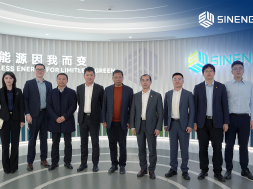
Liquified hydrogen receiving terminal at the time of construction in Kobe
To get a clear view of our planet’s carbon-neutral future, it helps if you’re in Japan.
As renewable-energy efforts to combat climate change ramp up around the globe, Japan’s aggressive goal of carbon neutrality by 2050 applies a full-steam effort to implement innovative ideas and technologies. One of these resources is only starting to reveal its full potential: hydrogen.
Green Growth Strategy
In October 2020, the Japanese government declared the goal of realizing a carbon-neutral, decarbonized society by 2050. In light of this mission, the Ministry of Economy, Trade, and Industry (METI) formulated the Green Growth Strategy, a comprehensive industrial policy that promotes research and development to drastically reduce Japan’s greenhouse gas emissions and lead the green industry globally.
METI maps out the Green Growth Strategy in 14 growth sectors within three main categories:
Transportation and manufacturing: mobility and batteries; semiconductors and information and communications technology (ICT); maritime; logistics, people flow, and infrastructure; foods, agriculture, forestry, and fisheries; aviation; and carbon recycling
Home and office: housing and building; resource circulation; and lifestyle-related industry
Energy: offshore wind power; fuel ammonia; nuclear power; and hydrogen
Hydrogen: The Newest Clean Energy
Of these 14 Green Growth sectors, one of the most unexplored—especially outside Japan—may be hydrogen. Japanese companies lead the world in hydrogen turbine combustion technology, making the element a rising component of Japan’s clean-energy portfolio. A primary driver behind Japan’s reputation as the world’s forerunner on hydrogen—a clean energy that emits no CO2—is Kobe, Japan–based Kawasaki Heavy Industries (KHI), a pioneer in efficient, large-scale storage and transport of liquefied natural gas (LNG) in Asia.
Hydrogen has historically proved difficult to store in large volumes and to transport long distances. But KHI, with its proprietary liquefaction system and advances in hydrogen innovations, is changing that.
Liquefaction and Distribution Technology
In 1981, KHI became the first Asian company to manufacture an LNG carrier. Since this milestone, the company has become a leader in cryogenic technology for maritime transportation.
Since 1983, the company has developed, manufactured, and operated a liquefied-hydrogen storage tank at the rocket-launch site facility of the JAXA Tanegashima Space Center.
These innovations will lead to safely shipping liquefied hydrogen in large quantities over long distances by sea. In 2019, KHI launched the Suiso Frontier, the world’s first liquefied-hydrogen carrier, which uses proprietary cryogenic technology to keep hydrogen liquified at -423℉(-253℃), 1/800 of its original gas-state volume.
As a leading member of the CO2-free Hydrogen Energy Supply-Chain Technology Research Association (HySTRA), KHI is also involved in building processes to unload liquefied hydrogen at large-scale storage facilities.
Japan’s New Energy and Industrial Technology Development Organization (NEDO), a national funding agency for research and development, subsidized a HySTRA program—the demonstration project to establish a mass hydrogen marine-transportation supply chain derived from unused brown coal—from FY2015 to FY2020 and is now launching a pilot demonstration to build a hydrogen supply chain, with the goal of its commercialization around 2030.
NEDO also granted KHI a subsidy from FY2019 for “larger size of transport and storage equipment for liquefied hydrogen and development of receiving base equipment.”
Hydrogen Today and Tomorrow
Hydrogen represents not only the future of Green Growth, but also its present.
In 2018, Kobe became the world’s first urban area to use an entirely hydrogen-powered gas turbine, when KHI, partnering with Obayashi Corp. and others ran a test to supply hydrogen-powered steam heat and electricity to four facilities: 1) Kobe City Medical Center General Hospital, 2) Kobe Port Island Sports Center, 3) Kobe International Exhibition Hall, and 4) Port Island Sewage Treatment Plant.
Public education campaigns on hydrogen’s cleanliness and safety have helped residents understand they can lead their daily lives without inconvenience or concerns about this experimental energy source.
Hydrogen’s next applications may be to power heavy trucks, buses, ships, and trains—and, in the following stage of development, to power a greater expanse of the power grid. Japan’s hydrogen strategy targets 2030 for commercializing the liquefied-hydrogen supply chain and using hydrogen for the electric power field.
With the global turbine market expected to reach nearly USD$220 billion (¥23 trillion) by 2050, METI anticipates Japan to lead on hydrogen, with international trade of hydrogen to be nearly USD$52 billion (¥5.5 trillion) annually.
Joining the Carbon-Neutral Future
As CO2 accounts for more than 80% of its greenhouse gas emissions, Japan recognizes the importance of transformation for the sustainable future of its socioeconomic structure, industrial structure, and business models through hydrogen and other sectors of the Green Growth Strategy.
Today, Japan is attracting corporate investment and innovation to 14 growth sectors defined in the Green Growth Strategy by offering tax incentives as well as research-and-development funding from its 10-year, USD$18.9 billion (¥2 trillion) Green Innovation Fund. Growth-oriented regulatory measures are under deliberation in Japan’s legislature, the Diet.
By the end of January 2021, more than 70 companies in Japan had declared carbon neutrality. The time is right for companies to join Japan’s carbon-neutral future















